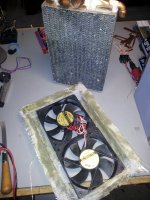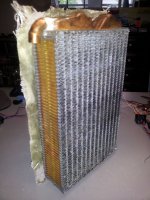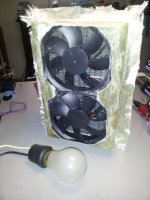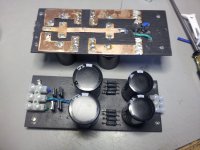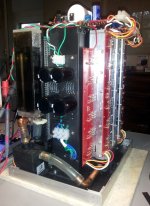As for liquid cooling of the speakers, I was thinking about just immersing them in seawater. There is plenty nearby, and the possibility of the speaker changing the temperature of that 'heatsink' is fairly remote...
And perhaps you could play some Hendrix for the propellerheads running the SOSUS nets...
And perhaps you could play some Hendrix for the propellerheads running the SOSUS nets...
mmmm??? seawater, salt and electronics equals,..... a painful death of your equipment??
after all thats been said in the last few posts thats NOT what stands out as crazy!
Yes but how are they at bike repair ?All,
I've read recent postings about liquid cooling of Pass DIY amps.
My next door neighbors--Wilbur and Orville Wong--recently developed a liquid helium (H3) cryostat cooling system for the F5 Turbo V3. It works at 0.365 degrees Kelvin--and thanks to superconductivity, is 132.78% efficient. Working in their garage workshop (picture shown) they developed the cooling system for $3.23 (US) using parts from a Maytag washing machine, Yugo station wagon, and a Mercury outboard motor.
The picture shows the obvious jubilation of Wilbur and Orville, right after they measured the Turbo V3's output at 3.446 KW into 0.2 ohms. Wilbur found no problem in holding Orville's hand to the heatsink for more than a minute--although Orville subsequently lost several layers of skin and suffered severe hypothermia in attempting to remove his hand afterwards.
Ohhhh..... There is something so wright about their concept, and yet something so wong in their execution.
Enjoy....... Pass DIY and Class A forever.....!
Sneak Peek - If my little BA-3 experiment works out as hoped, you can just pipe it into your central air ducts and heat the whole d*mn house - or get some very long speaker cables and move it around to the coldest spot in your castle !!! 


As expected, please ignore what I said at post #2220 (Cal's Rule: "Never post an end date to a project"). Probably have another full week before I'm making any "cool music".
As expected, please ignore what I said at post #2220 (Cal's Rule: "Never post an end date to a project"). Probably have another full week before I'm making any "cool music".
Attachments
Last edited:
Just need some very long feeder hose for the heat exchanger and short speaker cable . look good.Sneak Peek - If my little BA-3 experiment works out as hoped, you can just pipe it into your central air ducts and heat the whole d*mn house - or get some very long speaker cables and move it around to the coldest spot in your castle !!!
As expected, please ignore what I said at post #2220 (Cal's Rule: "Never post an end date to a project"). Probably have another full week before I'm making any "cool music".
Sneak Peek - If my little BA-3 experiment works out as hoped, you can just pipe it into your central air ducts and heat the whole d*mn house .
Bob, at some point in time, you might want to add some "water wetter" to your coolant water. It tends to improve the cooling capacity of the water (I think it promotes better metal to water boundary transfer). I use it on my race cars--and if it gives me a 15 degree C temp reduction on my McLaren (1,000 HP from 355 cu in), then it ought to be able to help cool your amp, too. I used the additive made by Red Line.
Attachments
That gets more amazing each time I see it. Love the home made PS PCB!!
++ on the Red Line "water wetter".
Last edited:
Does that save any space/volume/cost compared to fan cooling or passive cooling?
Won't have a definitive answer till the final build is completed. If I can improve the heat transfer efficiency at the fets, the radiator/fan module could be smaller. Compare: Radiator @ $27, fans @ $9 ea. pump @ $33 = around $75 w/fittings - to the cost of a quality chassis with sufficient heatsinking for 24 devices. The shell will be made from a sheet of aluminum costing ~ $40.
6L6 is correct. It's the last leg of a curiosity based adventure that hopefully might spur some practical developments/alternative in the liquid cooling concept. Received PM from others who have started similar projects. We will see what the future brings.
Edit: Thanks Bill. The CL-60 part was made with the leftovers from the PS construction. I will get the WW soon and report back.
Last edited:
- Home
- Amplifiers
- Pass Labs
- Pictures of your diy Pass amplifier
